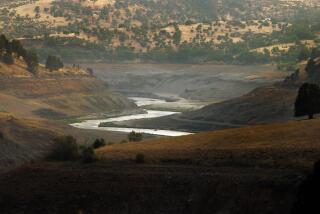Finding power in old hydroelectric dams
- Share via
HOLTWOOD, PA. — The century-old dam on the Susquehanna River doesn’t look like an energy source of the future.
Weeds sprout out of cracks in the weathered Holtwood Hydroelectric Dam, 12 miles upriver from Maryland. Inside the generating building, antique brass volt meters look like something from Dr. Frankenstein’s lab. Water snakes slither across the floor.
Despite the decrepit appearance, a Pennsylvania power company is planning to spend $350 million to build water-powered turbines next to the dam. The first new hydroelectric power plant in the East in 20 years, it would double the dam’s electrical output, providing another 100,000 homes with pollution-free electricity, the company said.
At a time when utilities are looking to generate more power without making global warming worse, some point to the PPL Corp.’s Holtwood project as a good example of going back to the future.
“Hydropower has been nearly forgotten, but it’s a great source of electricity because it’s completely emission-free and combustion-free generation,” said Douglas Hall, manager of the water energy program at the U.S. Department of Energy’s Idaho National Laboratory.
Increasing the efficiency of old plants can create more juice to meet rising demand, Hall and others say. Power companies are upgrading generators in 23 dams in Idaho, Kentucky and California, among other places.
Hydroelectric dams were the original source of electricity for many of America’s cities a century ago. As late as the 1940s, 40% of the electricity in the U.S. was generated by water pushing wheels and spinning turbines. But the technology was neglected after World War II as coal-burning plants took over the dominant role in generating America’s electricity.
America today gets 7% of its electricity from hydroelectric power, and it could rise to perhaps 11% simply by adding more and better generators to existing dams, Hall said. That would mean more clean energy without blocking additional rivers or flooding more valleys -- major environmental drawbacks that halted most construction of dams in the U.S. by the 1950s.
There are about 79,000 dams, many dating to grain mills of the 19th century. Only 2,400 of these dams have hydroelectric generators built into them. Adding more turbines to the existing dams could add as much as 37,000 megawatts of power, Hall said. That’s enough electricity to light up 27 million homes.
“There is growing interest in hydropower, because it is one of the potential solutions to global warming,” said Linda Church Ciocci, director of the National Hydropower Assn.
The addition of a second powerhouse at the Holtwood dam requires approval from the Federal Energy Regulatory Commission and the Pennsylvania Department of Environmental Protection, among other government agencies. If the project is approved, construction could begin early next year and be finished by 2011.
The proposal has drawn no major protests from environmental groups, although American Rivers urged federal officials to consider the effects of construction blasting on wildlife, according to agency records. But officials with the U.S. Fish and Wildlife Service and the Maryland Department of Natural Resources have suggested that improved flow through the rebuilt dam might actually help migratory fish.
The dam, a five-story-high wall of concrete finished in 1910, transformed the rocky, shallow river into a deep blue reservoir, called Lake Aldred, which is eight miles long. It’s the second of four hydroelectric dams that radically transformed the Lower Susquehanna from a natural river into a stepped series of artificial lakes.
Attached to the Holtwood dam is a rectangular building, 500 feet long, 100 feet wide and 150 feet tall, with ornate neoclassical decorations and rows of grand arches. Inside hum 10 hydroelectric generators, each about 20 feet in diameter.
About 240,000 gallons of water per second from the river rush through a screen that catches floating sticks (and often water snakes). The current pushes blades on wheels, making turbines spin. This generates 109 megawatts of electricity, enough to light up about 90,000 homes.
Some of the machinery is so old that it has been designated an International Historic Mechanical Engineering Landmark.
“The architecture is pretty amazing,” said Chris Porse, manager of the Holtwood dam. “The arches are reminiscent of Roman architecture. It’s a reminder that water power has been around for centuries, with the Egyptians, Romans and Greeks all using it.”
An environmental activist who has been studying the project, Michael Helfrich, said adding more turbines could chop up more fish that pass through the dam. But he said adding more hydroelectric generation was a good idea.
He noted that this section of the Susquehanna is already one of the most generating-intensive areas of the world. Two nuclear plants, four hydroelectric dams, a coal-fired plant, a natural gas plant and a municipal incinerator all line a 50-mile stretch of the river.
More to Read
Sign up for Essential California
The most important California stories and recommendations in your inbox every morning.
You may occasionally receive promotional content from the Los Angeles Times.













